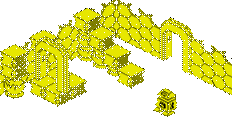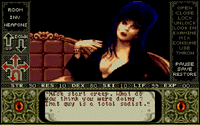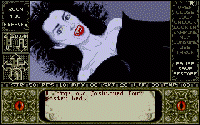| Videos | Screenshots (Commodore Amiga) | | (no videos on file) | |
Please
login to submit a screenshot
 Iss 19 Feb 1991
Iss 19 Feb 1991 (Amiga Format) 4th Dec 2011 10:17
Elvira, the lady with the big reputation, wants a hand with her chest. She has opened up her old ancestral home Castle Killbragant and along with it a real can of worms – the really slimey ones. She has also reawakened an ancient curse, placed by her great, great, great, grandma, who it appears ws not so great after all.
The spooks and demons have come out of the closet and trapped Elvira in her own home. In answer to a small ad you are now her rescuer. Searching through the castle you must find six keys that will unlock an ancient chest and lift the curse. Easy? It would be if the ghosts did not carry loaded swords and were not able to use magic – not any of your Paul Daniels rubbish either, this stuff really hurts.
Carry On Elvira
Guided by the lovely Miss E’ you roam around the castle killing guards, fighting monsters, receiving horrendous wounds abd being healed by Elvira’s own sweet hands. As it is the family home of the Elvira clan the place is full of unexpected tunnels, guardians and other suprises. Nothing is what it seems and the level of innuendo and derision is along the lines of a "Carry On" film and are only ever a wobbling breast away.
Elvira, and her accompanying house, are beautifully drawn and the story created by all your wandering is well animated with arcade style sub-games around every corner: from sword fighting to breath holding feats, they are all yours to try. All you have to lose is your life, so why not give it a go?
Get Y’er Disks Out!
Elvira is flawed however, in many painful ways. The most frightening is the sheer number of disks; five to be exact. You get your moneys worth though, as virtually every movement between locations forces disk access. Irritation soon starts to get in.
The adventure though, is well thought out, with a strong side-line in role-play underpinning the plot. As you roam, most of Elvira’s ghostly ancestors insist on sword battles. Seeing as your starting weapon is only a dagger, they are not easy to win. Yet victory earns you experience in handling the weapon and access to another room or area.
Two Strokes Are Enough
Sword battles are limited to two strokes on attack and two on defence. You have to select which blow the other guy is going to try and react accordingly. A simple sub-game of guess the sword stroke, it is at the heart of the game’s earlier stages. Unfortunately, fighting with the dagger and no visual guides means that you take many more blows than you should. Elvira has given you masses of healing potions, but these cannot be used during the battle. Henceforth, and rather fittingly for a Gothic game, you spend large amounts of time dead.
The slowness and the repeated deaths ruin Elvira. It is simply no fun to play. The frustration is heightened by the graphics because so many remain unseen. Success is a matter of persistence and luck. Still, Elvira does have nice...
Trenton Webb
 Alec Foster
Alec Foster (Retro Revisited) 26th Jul 2018 04:38
Of all the games I owned for my Commodore Amiga, Elvira: Mistress of the Dark, remains one of the most memorable. Based on the character of Elvira – portrayed by Cassandra Peterson – the game follows in the footsteps of the 1988 comedy horror film released a couple of years earlier, although the game’s story is completely separate to that of the film.
Whilst I’m sure that part of the game’s appeal came from Ms. Peterson’s likeness appearing on the game’s box and in-game, especially amongst a certain demographic of spotty, teenage schoolboys, it’s certainly not what made a lasting impression. Horrorsoft was a developer that lived up to it’s moniker, for this was a truly scary game, particularly to an audience of young gamers growing up in the early 90’s. The game contains some particularly graphic and gory scenes that were way beyond the cartoon violence depicted by the likes of Mortal Kombat, and it’s these scenes for which the game is truly memorable.
The game commences shortly after the death of Elvira’s evil Uncle Elmo (no relation to the Sesame Street muppet). It seems that Elmo was a man of means and has bequeathed the crumbling ruin that is Castle Killbragant to Elvira, who in turn has decided to turn it into a tourist attraction for horror fans. Unfortunately, Elvira discovers that her vampiric, Satan-worshipping ancestor, Queen Emelda, has been reincarnated and is lurking somewhere in the bowels of the castle’s crypts. Unsurprisingly, the threat of being devoured by Hellspawn doesn’t make for a particularly fun day out, so Elvira enlists the help of our nameless hero, who travels to the castle to locate and destroy Emelda once and for all.
The game is a tile-based, 3D dungeon-crawler with strong emphasis on exploration, puzzle-solving and a liberal helping of combat; if you’ve played titles such as Dungeon Master then you’ll be familiar with what to expect. Players must navigate their way around the castle and accompanying locations, gaining items and knowledge as to how they might defeat Emelda, not to mention dealing with a regiment of murderous guards and grotesque horrors that now infest the castle.
After a brief introduction sequence, the player is dumped outside the gatehouse and is left to get on with the job. With little direction and complete absence of guides or help, Elvira is very much a game of discovery, trial and error. Such errors lead invariably to the abrupt (not to mention grisly) death of the player, and it is a frequent occurrence to become some monster’s lunch, either because you failed to be carrying the correct item, were too slow or simply tried to use it at the wrong time. Fortunately, the game does has a save feature that enables you to reload to an earlier point in time and it is vital to make use of it so as to prevent having to play from the beginning each time you die.
Even by today’s standards, the artwork in the game is excellent. Each of the individual locations has been drawn with great attention to detail. From character sprites to background artwork, everything looks absolutely gorgeous, with special mention going to the truly gruesome death scenes when the player gets to witness the true folly of their actions, all rendered in grisly detail!
A large component of the game involves interacting with and collecting items within the game world. Clicking on an item and dragging it to the bottom of the screen will add it to the player’s inventory – it’s a good job that our hero remembered to bring his bottomless rucksack with him! Items that you need are not always immediately obvious and you often need to to undertake a degree of pixel-hunting as you comb the screen with the mouse cursor in an effort to discover objects that you can interact with, before struggling with finicky drag-and-drop functionality in an effort to get it into your inventory.
The actual inventory and management thereof is one of the weaker elements in the game. You’ll collect a huge number of objects over the course of the game, but you can’t reorder the items in which they appear, so you’ll spend precious minutes scrolling through pages of inventory looking for the item you want. This is all less than ideal when you consider that certain sections of the game demand that you use a specific item at a specific time to prevent an untimely demise – there’s no way you have time to scroll through 15 pages of inventory, so you must ensure that you’ve already got the item required visible and ready to use.
As previously mentioned, the game features a significant level of combat and a basic role-playing system. Certain encounters are scripted and occur at a fixed point in time, but others will occur at random as you move throughout the game. The start of combat is marked by a short animation, usually with a guard emerging from a doorway with a drawn sword in a moment that only adds to the tension.
Once combat begins, the interface updates to display the foe in the main window, with combat dialogue buttons appearing to the right of the screen. Combat occurs in real-time, but the game imposes an attach and defend mechanism where the roles of attacker and defender are assigned to the player and their adversary. When in defence mode, the player must choose whether to block or parry an incoming blow – blocking protects against attacks from the left, whilst parrying deflects those from the right. Success at defending boils down to correctly preempting which side the opponent is going to strike and clicking the appropriate button, hoping that you made the right choice. To complicate matters, the player must also time their deflection correctly as their guard only lasts a short time and there is a cool-down after blocking, leaving the player open to attack if they clicked too soon. It’s all too easy to lose your sense of timing, usually resulting in swift and painful death under a rain of sword blows.
Should the player successfully deflect an attack, the roles are reversed and it the player enters attack mode and gains a limited opportunity to strike back. The block/parry buttons are replaced with “hack†and “lunge†options, alternating the direction from which the player will strike. The computer will do some behind-the-scenes calculations to determine whether it deflects the blow or not, but a good strategy is to alternate attacks to increase chances of landing a succession of blows. The enemy cannot counter-attack until it successfully deflects a strike, so mixing things up can really give you the edge in combat.
Surviving these encounters will see a gradual increase your characters abilities (displayed underneath the main viewing window) throughout the game. Strength improves the amount of damage you can do with any given weapon, whilst dexterity and skill (quite literally) improves your characters reactions; enemies with a higher dexterity than you will attack relentlessly, giving you little opportunity to react – it’s definitely worth learning out where these are located and only engaging them once you feel ready.
Another feature of the game is the spell system, which allows the player to harvest ingredients throughout the game world and for Elvira to use them in the preparation of spells. The effects of the spells range from healing potions to offensive powers, whilst others are required to complete certain puzzles. It’s also possible to craft a range of healing salves and potions to restore life lost through combat and it’s recommended that you always keep several of these handy, provided you’ve found enough ingredients.
At this point, I should give a special mention with regards to the the game’s audio. The music is genuinely haunting, especially that which plays inside the castle courtyard – the game was released at a time when the Amiga’s sound capabilities trounced the abilities of the average PC and Elvira is one such title where Commodore’s machine clearly gave the best experience. The grungy synths help to convey a suitably haunting atmosphere that leaves the player in a perpetual state of trepidation. There also some brilliant sound effects and digitised speech samples, particularly that of the guards who howl in pain when you manage to land a successful blow. Even now, I still get panicked by the unnerving, squishy sound of the guard’s sword biting into your characters flesh, knowing full well that the blow will have brought you one step closer to failure.
Ultimately, I think Horrorsoft did an excellent job in crafting an engaging title that fans of adventure games are sure to enjoy. Some of the mechanics may be frustrating and the puzzles somewhat obscure at times, but this is most certainly a game that is the sum of it’s parts, combining excellent graphics, audio and pacing to create a truly memorable experience.
 (Anonymous)
(Anonymous) (Unknown) 24th Nov 2010 10:02
Title Elvira - Mistress Of The Dark
Game Type Adventure
Publisher Horrorsoft/Accolade 1990
Players 1
Compatibility ?
HD Installable no
Submission Richard Hoffmann, richy@hadiko.de
Review
Elvira appeared in 1990 and is an adventure/RPG classic from Horrorsoft
(licensing to Accolade at that time). The goal of the game is to free
Elvira from a spooky castle. As usual in RPG games, the player starts with
no experience and weak fighting skills, which improve after defeating
enemies. At the beginning the player has to solve several puzzles in the
castle, encountering only some knights. As the player has gained some
experience from the fights, more challenging opponents await in the
catacombs below the castle and in a maze located in the garden outside the
castle. Apart from the fighting, the player can also cast spells, which are
mixed by - Elvira! These include fighting and healing spells. The
necessary ingredients for the spells are scattered all over the castle.
Some oppenents can only be defeated with specific weapons or spells. In
general the adventure part is clearly dominating though, the fights are
more or less for a change.
The player walks through rooms and catacombs in the 1st person
perspective; like usual at that time, not smoothly but in steps. Whenever
enemies are encountered, the screen switches to a 2d view where the
opponents have to be fought in realtime.
The atmosphere of the game is great, as well as the graphics; infact
Horrorsoft are amongst the first ones who used digitized Pictures and even
Video Sequences with Elvira! These show up from time to time in the game,
for example when the player has solved a specific puzzle or enters a
certain place. The overall game concept is thought out well and neither
the fighting nor the adventure part are too tough in this game. The music
additionally supports the eerie atmosphere and is composed very well.
Elvira is available for the C-64 as well, but has not been ported to the
PC as far as I know.
|
Add your own review for Elvira Mistress of the Dark! Fill in this section now!
|
|
| Cheats | Trivia | | There are no cheats on file for this title. | No trivia on file for this title. |
History
This title was first added on 9th March 2006
This title was most recently updated on 4th December 2011

 Accolade Inc
Accolade Inc Iss 19 Feb 1991 (Amiga Format) 4th Dec 2011 10:17
Iss 19 Feb 1991 (Amiga Format) 4th Dec 2011 10:17 Alec Foster (Retro Revisited) 26th Jul 2018 04:38
Alec Foster (Retro Revisited) 26th Jul 2018 04:38 (Anonymous) (Unknown) 24th Nov 2010 10:02
(Anonymous) (Unknown) 24th Nov 2010 10:02







